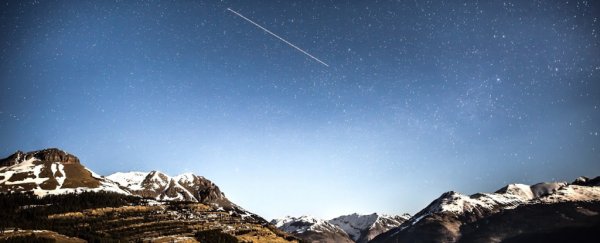Never heard of the Eta Aquarid meteors? 2019 offers a good chance to check out this normally obscure meteor shower.
This year offers an especially good chance to spy these fast-moving meteors. First off, the peak for this shower arrives on the morning of Monday, May 6 less than 40 hours after the New Moon.
This means that the Moon will be a thin, 4 percent illuminated waxing crescent low in the dusk sky come Monday night, out of view when the shower reaches its peak. Speaking of which, the Eta Aquarids have a broad peak centered on May 6, running from April 19 to May 28.
If you're clouded out come Monday morning, it's still worth watching for meteors on Sunday or Tuesday, just in case.
The exact peak for the 2019 Eta Aquarids is expected to arrive on May 6 at 14:00 UT/10:00 EDT, favoring the southwestern Pacific region.
At their maximum, expect the Eta Aquarids to produce a Zenithal Hourly Rate (ZHR) of 50 meteors per hour. Keep in mind, however, the ZHR is an ideal rate, assuming dark skies with a radiant straight overhead near the zenith.
Most observers will see a rate considerably lower, mainly due to light pollution and the true position of the radiant.
The Eta Aquarids appear to radiate from a point (known as the shower's radiant) just a few degrees west of the +4th magnitude star Eta Aquarii (hence the shower's name) located in the astronomical constellation of Aquarius the Water-Bearer.
The radiant is also very near the famous "Y-shaped" asterism in Aquarius of Um the Water Jar. Aquarius also hosts another elusive meteor shower: the July Delta Aquarids.
The parent comet for the Eta Aquarids is none other than that most famous comet of them all, 1/P Halley. In fact two debris trails from Halley's Comet intersect the orbit of Earth, and the comet also gives us the October Orionids.
The Eta Aquarids: A Brief History
Like Halley, the Eta Aquarids are on a retrograde stream orbiting the Sun.
We see the outward trail from Halley during Eta Aquarid season, with the incoming inward trail during the October Orionids.
Either trail is coming at the Earth nearly head-on, producing relatively swift meteors moving at about 66 kilometers per second.
Now, for the bad news. For observers up north, the Eta Aquarid radiant doesn't rise above the southeastern horizon until about 2 am local time; expect rates to pick up towards dawn. Down under, the reverse is true: in fact, folks in South Africa and Australia consider the Eta Aquarids to be one of the best annual meteor showers.
The Eta Aquarid stream also seems to be ancient, in the 2,000-3,000 year old range. There also seems to be an 11 year periodicity for the Eta Aquarids, probably caused by gravitational perturbations on the stream caused by the planet Jupiter. 2013 was a fine year for the Eta Aquarids with a ZHR approaching 140 per hour, while we seem to be coming off of a relative lull seen in 2016-2018.
Also, another poorly understood meteor shower peaks on May 8: the Eta Lyrids.
This also seems to be a new stream, laid down by the 198- passage of Comet IRAS-Araki-Alcock, just 0.03 astronomical units (AU) or only 4.6 million kilometers from the Earth.
The Eta Aquarids are one of the very few major showers with a radiant located in the southern hemisphere… barely. The exact radiant position for the Eta Aquarids is Right Ascension 22 hours, 20 minutes, Declination -1 degrees south.
Why are all of the good meteor showers up north? Is this just a statistical fluke, or is some other process at play? We've never seen this anomaly addressed in meteor astronomy.
Observing meteor showers is as simple as laying back and watching with a good Mk-1 pair of eyeballs and waiting for an Eta Aquarid to glide silently by.
Be sure to watch in the early morning hours for best results, as you'll be on the portion of the Earth turned forward into the oncoming meteor stream.
Be sure to find as dark an observing site possible for best results, otherwise, fainter Eta Aquarids will pass right by unobserved.
Hear a meteor crackle? You're not imagining things: audible meteors are a real phenomenon, and eerie to witness.
Reporting Meteors
How many meteors do you see? Count 'em up per hour, and you can report your observations to the International Meteor Organization (IMO).
It's one of the very few ways that naked eye observers can still contribute to modern astronomy.
You can also photograph meteors simply by aiming a tripod-mounted DSLR camera at the sky and taking time exposures of 30 seconds to 3 minutes in duration. We like to use an intervalometer to simply take an automated series of timed shots of the sky, to free us up to lay back and watch the show.
Good luck, and clear skies!
Also keep an eye out for any Eta Aquarids early tomorrow morning, as SpaceX's Dragon heads up the US East Coast.
This article was originally published by Universe Today. Read the original article.
